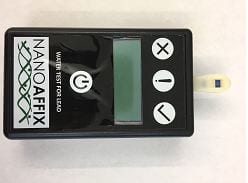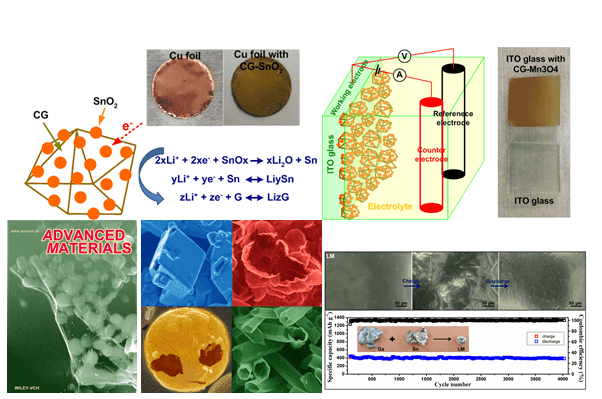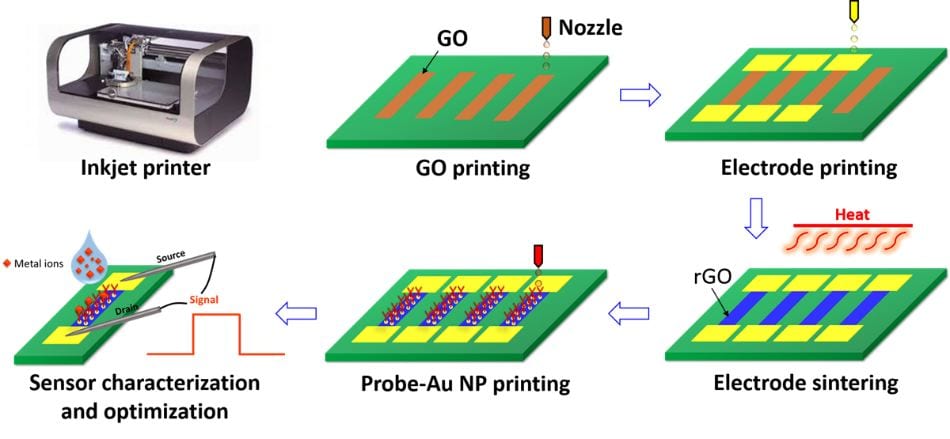Nanotechnology for Sustainable Energy and Environment (NSEE)
Our research goal is to impact our society through scientific discoveries and sustainable technological innovations. My research interest thus lies in nanomaterial innovations, particularly hybrid nanomaterials featuring rich interfaces, for sustainable energy and environment. Our approach is to combine multidisciplinary experiments with first-principles calculations to design and discover novel nanomaterials for engineering various sensing and energy devices with superior performance. The sensors address the current unmet need for low-cost, real-time, sensitive and selective detection of a wide range of analytes attractive for innovation at nexus of food-energy-water systems (INFEWS), smart and connected health (SCH), smart and connected communities (SCC), Internet of Things (IoT), and next-generation smart and resilient infrastructures, through interfacing with smart phones and terminals loaded with machine-learning, big-data analytics. The energy devices address the current need for cost-effective, high-performance production and storage of renewable energy. Our research also attempts to address the low-cost, scalable nanomanufacturing of such sensor and energy devices through additive manufacturing such as inkjet printing. Finally, my group is dedicated to technology translation and commercialization through industrial partnership. The schematic below presents an overview of my research program, which can be categorized into the following five thematic areas.
Theme 1: Molecular Engineering of Next-generation Nanomaterials
Theme 2: Real-time Sensors for INFEWS, SCH, SCC, and IoT
Theme 3: Cost-effective Energy Devices for Renewable Energy Production and Storage
Theme 4: Scalable Nanomanufacturing of Electronic Devices and Systems through Inkjet Printing
Theme 5: Nano-enabled Water and Air Pollution Control

Theme 1: Molecular Engineering of Next-generation Nanomaterials
Our group is interested in molecular engineering of novel nanomaterials beyond what are currently available and then demonstrating their exciting applications. Examples of these nanomaterials include crumpled graphene (CG), vertically-oriented graphene (VG), and hybrid nanocrystals – graphene/carbon nanotube (CNT) structures. Active hybrid nanomaterials represent a new class of nanomaterials that could potentially display not only the unique properties of nanocrystals and those of nanotubes or graphene, but also additional novel properties due to the interaction between the nanocrystal and the CNT or graphene. These hybrid nanomaterials are promising for a wide range of applications including in nanoelectronic and optoelectronic devices, catalysis, nanomanufacturing, renewable energy harvest and storage, biomedical engineering, and environmental remediation. The availability of affordable hybrid nanostructures and their fundamental properties will thus accelerate new discoveries and inventions in nanoscience and nanotechnology. We have developed several methods to produce hybrid nanostructures with considerable control. We are interested in investigating the fundamental properties (e.g., interactions between nanoparticles and CNTs/graphene), molecular engineering, manufacture, and applications of the novel hybrid nanostructures through experiments as well as density functional theory (DFT) calculations.
Representative journal publications:
- S. M. Cui, H. H. Pu, S. A. Wells, Z. H. Wen, S. Mao, J. B. Chang, M. C. Hersam, and J. H. Chen*, “Ultrasensitive Sensitivity and Layer-dependent Sensing Performance of Phosphorene-based Gas Sensors,” Nature Communications 6, No. 3632, 2015.
- Z. Bo, S. Mao, Z. J. Han, K. F. Cen, J. H. Chen*, and K. Ostrikov*, “Emerging Energy and Environmental Applications of Vertically-Oriented Graphenes,” Chemical Society Reviews 44(8), 2108-2121, 2015.
- S. Mao, Z. H. Wen, Haejune Kim, G. H. Lu, P. Hurley, and J. H. Chen*, “A General Approach to One-Pot Fabrication of Crumpled Graphene-Based Nanohybrids for Energy Applications,” ACS Nano 6(8), 7505-7513, 2012.
- K. H. Yu, P. X. Wang, G. H. Lu, K. H. Chen, Z. Bo, and J. H. Chen*, “Patterning Vertically Oriented Graphene Sheets for Nanodevice Applications,” The Journal of Physical Chemistry Letters 2(6), 537-542, 2011.
- J. H. Chen and G. H. Lu, “Controlled Decoration of Carbon Nanotubes with Nanoparticles,” Nanotechnology 17(12), 2891-2894, 2006. (Highlighted by Nanowerk Spotlight, http://www.nanowerk.com/spotlight/spotid=545.php)
Theme 2: Real-time Sensors for INFEWS, SCH, SCC, and IoT
Miniaturized chemical and biological sensors that rapidly and accurately detect and differentiate trace amount of chemical or biological species are attractive for environmental monitoring, medical diagnosis, and lab-on-a-chip analytical devices. The objective of this research theme is to explore novel sensing platforms based on hybrid nanoparticle-CNT/graphene structures by taking advantage of electronic interactions between nanoparticles and CNT/graphene. The hybrid platform allows for the room-temperature sensing of a wide range of chemical or biological species at high sensitivity, which is otherwise unattainable with either nanoparticle sensors or CNT/graphene sensors. We have demonstrated a generic room-temperature gas sensing platform based on CNT/graphene-SnO2 nanoparticle hybrids for detection of low-concentration gases (e.g., CO, H2, NO2, NH3) and a versatile biosensing/water sensing platform based on CNT/graphene-Au nanoparticles for detection of proteins, DNAs, bacteria (e.g., E. coli), and heavy metal ions. Our research focuses on detailed characterization of the sensing platforms, understanding the sensing mechanism, optimization of the fabrication process, and scale-up of the process for multi-sensor fabrication. Our approach is to combine experiments (atomic, electronic, electrical, and spectroscopic characterizations) with theoretical modeling (e.g., DFT calculations) to establish the composition-structure-processing-sensing relationship for revealing the novel sensing mechanism.
2.1 Water sensors
Representative journal publications:
- G. H. Zhou, J. B. Chang, K. Y. Shi, S. Mao, X. Y. Sui, S. M. Cui, and J. H. Chen*, “Ultrasensitive Mercury Ion Detection Using DNA-functionalized Molybdenum Disulfide Nanosheet/Gold Nanoparticle Hybrid Field-Effect Transistor Device,” ACS Sensors 1(3), 295-302, 2016.
- S. Mao, J. B. Chang, G. H. Zhou, and J. H. Chen*, “Nanomaterial-enabled Rapid Detection of Water Contaminants,” Small 11(40), 5336-5359, 2015.
- G. H. Zhou, J. B. Chang, S. M. Cui, and J. H. Chen*, “Real-time Pb2+ Ion Detection Using Thermally Reduced Graphene Oxide Decorated with Functionalized Gold Nanoparticles,” ACS Applied Materials & Interfaces 6(21), 19235-19241, 2014.
- J. B. Chang, S. Mao, Y. Zhang, S. M. Cui, G. H. Zhou, X. G. Wu, C. H. Yang, and J. H. Chen*, “Ultrasonic-assisted Self-assembly of Mono-layer Graphene Oxide for Detection of Escherichia Coli,” Nanoscale 5(9), 3620-3626, 2013.
- K. H. Chen, G. H. Lu, J. B. Chang, S. Mao, K. H. Yu, S. M. Cui, and J. H. Chen*, “Rapid Hg(II) Ion Detection Using Thermally Reduced Graphene Oxide Decorated with Functionalized Gold Nanoparticles,” Analytical Chemistry 84(9), 4057-4062, 2012.
Media Coverage:
NSF Science Nation: https://www.nsf.gov/news/special_reports/science_nation/leadiondetector.jsp
AICHE CEP Magazine:https://www.aiche.org/resources/publications/cep/2017/july/catalyzing-commercialization-graphene-based-sensor-monitors-water-quality-real-time
2.2 Gas sensors
Representative journal publications:
- S. Mao, J. B. Chang, H. H. Pu, G. H. Lu, Q. Y. He, H. Zhang*, and J. H. Chen*, “Two-dimensional nanomaterial-based field-effect transistor for chemical and biological sensing,” Chem. Soc. Rev, in press,2017.
- S. M. Cui, H. H. Pu, S. A. Wells, Z. H. Wen, S. Mao, J. B. Chang, M. C. Hersam, and J. H. Chen*, “Ultrasensitive Sensitivity and Layer-dependent Sensing Performance of Phosphorene-based Gas Sensors,” Nature Communications 6, No. 3632, 2015.
- S. M. Cui, H. H. Pu, E. C. Mattson, Z. H. Wen, J. B. Chang, Y. Hou, C. J. Hirschmugl, and J. H. Chen*, “Engineering MoS2 Nanosheets through SnO2 Nanocrystal Decoration for Practical Sensing Applications,” Small 11(19), 2305-2313, 2015.
- G. H. Lu, S. Park, K. H. Yu, R. S. Ruoff, L. E. Ocola, D. Rosenmann, and J. H. Chen*, “Toward Practical Gas Sensing Using Highly Reduced Graphene Oxide: A New Signal Processing Method to Circumvent Run-to-Run and Device-to-Device Variations,” ACS Nano 5(2), 1154-1164, 2011.
- G. H. Lu, L. E. Ocola, and J. H. Chen, “Room-Temperature Gas Sensing through Electronic Transfer between Discrete Tin Oxide Nanocrystal and Multiwalled Carbon Nanotube,” Advanced Materials 21(24), 2487-2491, 2009. (Featured as Frontispiece)
2.3 Biosensors
Representative journal publications:
- Y. T. Chen, R. Ren, H. H. Pu, J. B. Chang, S. Mao*, and J. H. Chen*, “Field-Effect Transistor Biosensors with Two-dimensional Black Phosphorus Nanosheets,” Biosensors & Bioelectronics 89(1), 505–510, 2017. (Themed Issue on 2D Materials).
- Y. T. Chen, R. Ren, H. H. Pu, X. R. Guo, J. B. Chang, G. H. Zhou, S. Mao, M. Kron*, and J. H. Chen*, “Field-effect Transistor Biosensor for Rapid Detection of Ebola Antigen,” Scientific Reports 7: 10974, 2017.
- S. Q. Ci, T. Z. Huang, Z. H. Wen*, S. M. Cui, S. Mao, D. A. Steeber, and J. H. Chen*, ” Nickel Oxide Hollow Microsphere for Non-enzyme Glucose Detection,” Biosensors & Bioelectronics 54, 251-257, 2014.
- J. B. Chang, S. Mao, Y. Zhang, S. M. Cui, G. H. Zhou, X. G. Wu, C. H. Yang, and J. H. Chen*, “Ultrasonic-assisted Self-assembly of Mono-layer Graphene Oxide for Detection of Escherichia Coli,” Nanoscale 5(9), 3620-3626, 2013.
- S. Mao, G. H. Lu, K. H. Yu, Z. Bo, and J. H. Chen*, “Specific Protein Detection using Thermally Reduced Graphene Oxide Sheet Decorated with Gold Nanoparticle-antibody Conjugates,” Advanced Materials 22(32), 3521-3526, 2010.
Theme 3: Cost-effective Energy Devices for Renewable Energy Production and Storage
Energy storage devices such as lithium-ion batteries (LIBs) and electrochemical double layer (EDL) capacitors (sometimes referred to as ‘supercapacitors’ or ‘ultracapacitors’) are critical not only to stationary power generation (e.g., solar and wind energy harvesting) but also to mobile power sources (e.g., automotive applications). For instance, LIB technologies will be critical to driving the future energy applications, portable electronics, and electric/hybrid vehicles because of their high energy density with high cell voltage, low maintenance and because they are more environmentally friendly than nickel-cadmium batteries. Supercapacitors on the other hand could offer high power densities and rapid charging/discharging for instantaneous high load applications. Our research objective is to develop novel electrode materials based on hybrid nanostructures for high-performance LIBs and supercapacitors. We have demonstrated high capacity LIBs using graphene-Sn hybrids, vertically-oriented graphene, and crumpled graphene-SnO2 nanoparticle structures. We have also demonstrated supercapacitors with a high specific capacity using vertical graphene, high-porosity graphene, and crumpled graphene-Mn3O4 nanoparticle hybrids. This research is expected to result in novel methods to fabricate hybrid nanostructures at a low cost and a large scale for both LIB and supercapacitor applications and to shed lights on performance enhancement mechanisms.
Representative journal publications:
- P. Wu, L. Huang, X. K. Huang, X. R. Guo, D. Liu, D. Zheng, X. L. Zhang, R. Ren, D. Y. Qu, and J. H. Chen*, “Room-temperature liquid metal-based self-healing anode for lithium-ion batteries with an ultra-long cycle life,” Accepted to Energy and Environmental Science, 2017.
- Hou, Z. H. Wen, S. M. Cui, X. L. Feng*, and J. H. Chen*, “Strongly Coupled Ternary Hybrid Aerogels of N-deficient Porous Graphitic-C3N4 Nanosheets/N-Doped Graphene/NiFe-Layered Double Hydroxide for Solar-Driven Photoelectrochemical Water Oxidation,” Nano Letters 16(4), 2268–2277, 2016.
- K. Huang, J. Yang, S. Mao, J. B. Chang, P. B. Hallac, C. Fell, B. Metz, J. W. Jiang, P. T. Hurley, and J. H. Chen*, “Controllable Green Synthesis of Hollow Si Anode for Long-cycle-life Lithium-ion Batteries,” Advanced Materials 26(25), 4326-4332, 2014.
- B. Chang, X. K. Huang, G. H. Zhou, S. M. Cui, P. B. Hallac, J. W. Jiang, P. T. Hurley, and J. H. Chen*, “Multilayered Si Nanoparticle/Reduced Graphene Oxide Hybrid as a Lithium-Ion Battery Anode,” Advanced Materials 26(5), 758-764, 2014. (Front Cover)
- H. Wen, X. C. Wang, S. Mao, Z. Bo, H. Kim, S. M. Cui, G. H. Lu, X. L. Feng*, and J. H. Chen*, “Crumpled Nitrogen-Doped Graphene Nanosheets with Ultrahigh Pore Volume for High-performance Supercapacitor,” Advanced Materials 24(41), 5610-5616, 2012.
Theme 4: Scalable Nanomanufacturing of Electronic Devices and Systems through Inkjet Printing
Manufacturing electronic devices based on nanomaterials represents a nanotechnology grand challenge. Major issues associated with nanomanufacturing electronic devices include non-continuous manufacturing, device-to-device variation, relatively high cost, and relatively low yield. The electronics roadmap indicates that the market of printed electronics is estimated to exceed $300 billion over the next 20 years due to various advantages such as significantly lower costs. Printing technologies offer a solution for fabricating electronic circuits and devices while overcoming current challenges, and inkjet printing is a promising approach for fabricating low-cost electronics. Inkjet printing is a deposition technique used for liquid phase materials. These liquid materials, called inks, consist of a solute dissolved or materials dispersed in a solvent. Inkjet printing technology is based on digitally controlled generation and ejection of liquid ink drops from a printhead nozzle onto a substrate, which enables automated control and patterning. In particular, inkjet printing technology is well suited for manufacturing large-area electronics on flexible plastic substrates through a roll-to-roll process. Finally, inkjet printing technology is particularly compatible with various nanomaterials due to their small sizes and the ease of ink formation. We are addressing the current critical challenge of relatively high manufacturing cost of a novel, high-demand graphene-based water sensor by exploring a low-cost, customized inkjet printing process to reduce the sensor cost to pennies, which will significantly enhance the market acceptance of the new sensor product. The research entails engineering various inks and modifying the standard inkjet printing process to continuously produce the complete sensor system. Project results could be used for many other applications such as solar cells, lithium-ion batteries, and supercapacitors, enabling low-cost manufacturing of a wide range of printable electronic devices.
Theme 5: Nano-enabled Water and Air Pollution Control
Water is in seriously short supply in many regions of the world. Both for personal use — drinking, cleaning, cooking, and removal of waste — and large-scale use such as irrigation for agriculture, water must be available and sustainably provided to maintain quality of life. New technologies for desalinating sea water may be helpful, but small-scale technologies for local water purification may be even more effective for personal needs. Atmospheric direct current corona discharge from micro-sized objects has been widely used as an ion source in many devices, such as photocopiers, laser printers, and electronic air cleaners. However, ozone generation from these indoor corona devices poses significant health risks to indoor occupants. Our research goal is to control, degrade, and remove contaminants in water and air using nanomaterials and nanotechnology. We have developed a cost-effective route to a promising oxygen reduction reaction (ORR) catalyst, namely the nitrogen-enriched core-shell structured Fe/Fe3C-C (N-Fe/Fe3C@C) nanorods, with high activity and improved kinetics. The N-Fe/Fe3C@C was successfully used as cathode catalysts of microbial fuel cells (MFCs) and performed better than the commercial Pt/C-based cathode at the maximum power output. We have also demonstrated a highly porous N-doped graphene-based capacitive deionization device, which exhibits a high removal efficiency (90-100%), fast removal (<30 min), and good regeneration performance (10 cycles, 99% retention) for multiple heavy metals (Pb2+, Cd2+, Cu2+, Fe2+, etc.) in water with a wide range of concentrations (0.05-200 ppm). Finally, we have demonstrated corona discharges from CNTs and vertical graphene to minimize ozone generation from indoor corona devices.
Representative journal publications:
- L. J. Liu, X. R. Guo, R. Tallon, and J. H. Chen*, “Highly Porous N-doped Graphene Nanosheets for Rapid Removal of Heavy Metals by Capacitive Deionization,” Chemical Communications 53(5), 881-884, 2017.
- Y. Zhuang, F. Yu, H. Chen, J. Zheng, J. Ma*, and J. H. Chen*, “Alginate/graphene Double-network Nanocomposite Hydrogel Bead with Low-swelling, Enhanced Mechanical Property, and Enhanced Adsorption Capacity,” Journal of Materials Chemistry A 4, 10885-10892, 2016.
- Z. H. Wen, S. Q. Ci, F. Zhang, X. L. Feng, S. M. Cui, S. Mao, S. L. Luo, and Z. He*, and J. H. Chen*, “Nitrogen-Enriched Core-Shell Structured Fe/Fe3C-C Nanorods as Advanced Catalysts for Oxygen Reduction Reaction,” Advanced Materials 24(11), 1399-1404, 2012.
- Z. Bo, K. H. Yu, G. H. Lu, S. M. Cui, S. Mao, and J. H. Chen*, “Vertically-oriented Graphene Sheets Grown on Metallic Wires for Greener Corona Discharges: Lower Power Consumption and Minimized Ozone Emission,” Energy & Environmental Science 4(7), 2525-2528, 2011.
- Z. Bo, K. H. Yu, G. H. Lu, S. Mao, J. H. Chen*, and F. G. Fan, “Nanoscale Discharge Electrode for Minimizing Ozone Emission from Indoor Corona Devices,” Environmental Science & Technology 44(16), 6337-6342, 2010.


















